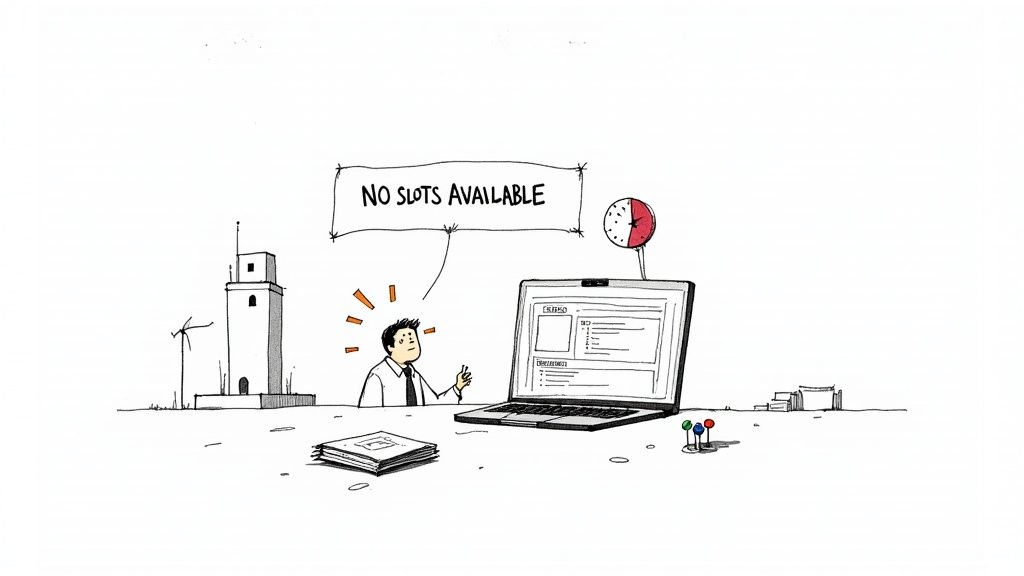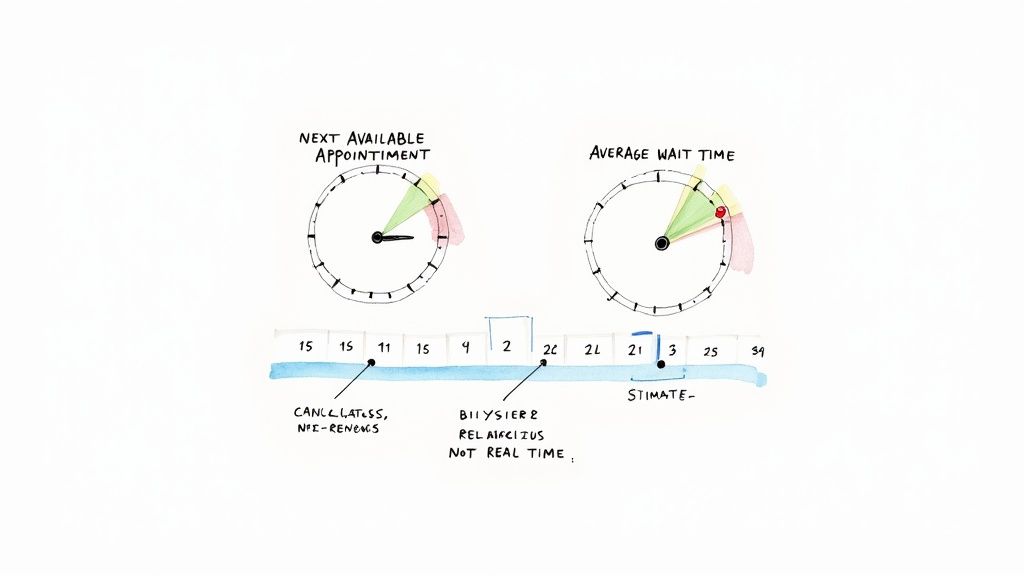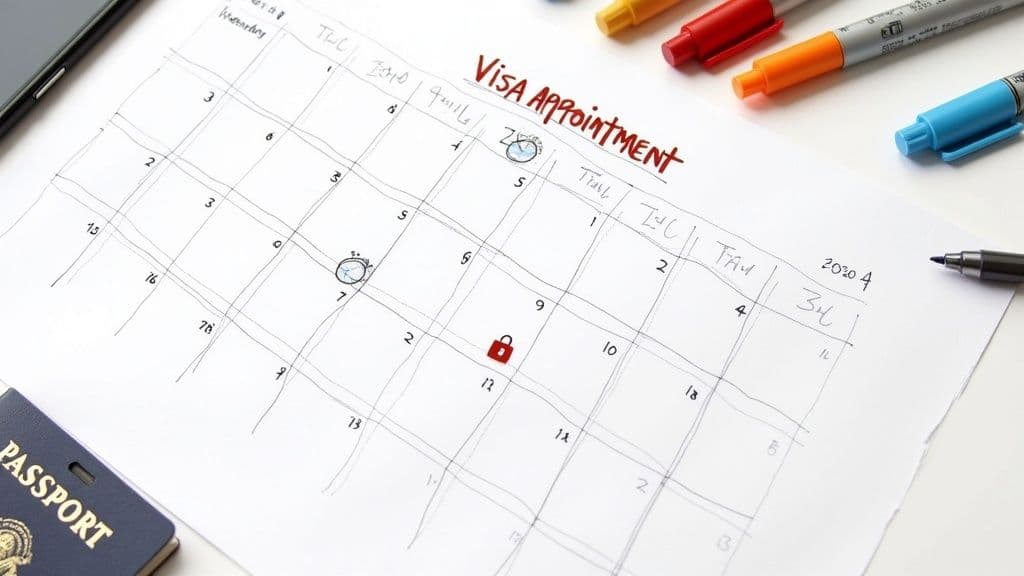So you’ve logged into the US visa scheduling portal, full of hope, only to be met with that soul-crushing message: "no slots available." It’s more than just a minor hiccup; for many B1/B2 visa applicants, it feels like hitting a brick wall.
The frustrating reality is that the demand for visa appointments massively outstrips the supply at most U.S. consulates around the globe. This isn't just a technical glitch. It's a hyper-competitive race where every open slot gets snatched up almost instantly.
Why You See No Available US Visa Slots

If you're staring at a screen with no appointments, take a small comfort in knowing you're in good company. This is an incredibly common ordeal for B1/B2 visa applicants everywhere, whether you're applying from your home country in Mexico or Colombia, or you're an Indian citizen trying to book a slot from Canada.
This problem is a perfect storm, created by a few key factors all hitting at once.
The Key Factors Driving Scarcity
The reasons behind the appointment drought go deeper than just "high demand." It's a complex issue stemming from the operational realities U.S. diplomatic missions are facing worldwide.
Here's what’s really going on:
Lingering Post-Pandemic Backlogs: Many consulates are still digging out from the mountain of applications that piled up when routine visa services were shut down.
Consular Staffing Limitations: There's a finite number of consular officers available to conduct interviews. Staffing levels directly dictate how many people can be seen each day. It’s that simple.
High Application Volume: Countries like Mexico, Brazil, and Colombia consistently have a staggering number of B1/B2 applications, which puts incredible strain on local consulates.
Right now, many applicants are grappling with historically long wait times, a direct result of this high demand clashing with limited resources. For instance, B1/B2 applicants in some major cities are looking at waits of 8 to 14 months. It can be even tougher for third-country nationals, where wait times in cities like Calgary and Toronto can stretch significantly. You can find more details in this guide on current US visa wait times.
The most important thing to understand is that visa slots are not released on a fixed schedule. They appear dynamically as other applicants cancel or as consulates add new capacity, often at random times.
This is the key. Slots pop up unpredictably. That's precisely why you need a persistent and strategic game plan. For a deeper look at the numbers, you can learn more about how the appointment waiting time for a US visa is calculated. Just hitting refresh now and then won’t cut it; understanding how the system works is your first step to getting ahead of the crowd and securing that interview.
How to Master the Manual Search for Appointments
If you're determined to find a US visa appointment on your own, you need a solid strategy. Just randomly refreshing the scheduling portal is a fast track to frustration and burnout. A much smarter approach turns this daunting task into a structured hunt for that golden slot.
The whole game is about thinking like the system and figuring out when new appointments are most likely to pop up. While there's no magic, publicly-posted schedule, some times are just logically better for checking than others.
Timing is Everything
Simply checking during your lunch break won't cut it. Slots from cancellations or newly released blocks of time often appear during off-peak hours, based on the U.S. consulate's local time zone. This means checking very late at night or incredibly early in the morning when fewer people are online competing with you.
For instance, if you're an applicant in Colombia trying to book at the U.S. Embassy in Bogotá, your best bet is to check the portal sometime between 11 PM and 5 AM local time. Competition is at its lowest during this window.
It's also critical to vary your check-in times. Logging in at the exact same time every day can sometimes trigger the system to flag your account for bot-like activity, which can get you temporarily locked out. Always mix up your schedule.
A huge mistake people make is only checking once or twice a day. The reality is, a canceled appointment can be snapped up in seconds. A disciplined but varied checking schedule—say, every hour within a specific late-night window—massively increases your odds.
Be Ready to Act Fast
When a slot finally appears, you have just a few seconds to claim it. If you hesitate, someone else who was better prepared will grab it from you. Your single greatest advantage in the manual search is being ready to pounce.
Before you even start looking, get all your essential information lined up and ready to go.
DS-160 Confirmation Number: Have it copied to your clipboard or waiting in a text file for a quick paste.
Passport Details: Know your passport number, issue date, and expiration date by heart or have them instantly accessible.
Login Credentials: Memorize your username and password for the scheduling portal so there's no fumbling around.
This isn’t about being glued to your screen 24/7. It’s about being prepared to act instantly the moment an opportunity arises. For a deeper dive into how slots become available, check out our guide on understanding US visa interview dates.
Best Practices for Manual Monitoring
To make your manual search as effective as possible, you need to adopt a few key habits. These will save you time and, more importantly, help keep your account from being flagged.
What You Should Do:
Check at inconsistent, odd hours (like 2:17 AM or 4:52 AM).
Use a fast, stable internet connection to cut down on page load times.
Always log out completely after each check instead of just closing the browser tab.
What to Avoid at All Costs:
Never use auto-refresh browser extensions. They are easily detected and will likely get your account blocked.
Don’t check from multiple devices at the same time using the same login.
Never share your login details with untrustworthy third parties.
By shifting your approach from random refreshing to a disciplined, strategic search, you can dramatically improve your chances of beating the "no slots available" message.
Using Automation to Find Visa Slots
Let's be realistic—for most B1/B2 visa applicants, manually checking for appointments just isn't going to cut it. The kind of commitment it takes to constantly refresh the portal, especially at odd hours, is a huge ask for anyone with a job or a family. This is exactly where automated tools come in and offer a serious strategic advantage.
Services like Vast Fisa take the guesswork and grind out of finding an appointment by handling the hardest part for you: the endless monitoring. These aren't "bots" hacking the system. Think of them as your personal assistant, programmed to watch the official scheduling portal 24/7. They're designed to spot newly released appointments and last-minute cancellations the instant they pop up—way faster than any human could ever hope to react.
For example, this is what it looks like when you set your preferences on an automated service. You can specify the exact date range and consulate locations you're targeting.
The real value here is obvious. You get back countless hours of your life and ditch the immense stress that comes with staring at that dreaded "no slots available" message.
How These Automated Services Actually Work
The whole process is built to be simple and secure, putting you back in the driver's seat. The idea is to shift the heavy lifting from you to the technology.
Here’s a quick look at what to expect:
First, you sign up with a reputable service.
Next, you provide your details securely, like your DS-160 number and any existing appointment date.
Then, you set your preferences. This is where you tell the service what you're looking for. For example, you might ask it to find any slot before a specific date at the consulates in Toronto, Calgary, or Vancouver.
Finally, you get instant alerts. The second a matching slot opens up, you'll get a notification shot straight to your email or another preferred channel.
This approach means you're acting on real opportunities instead of wasting your time on endless, frustrating manual searches.
Automation really levels the playing field. It turns the search from a game of luck and endurance into a structured, efficient process where technology is on your side. It’s simply a smart move for any serious applicant.
The Technical Advantage of Automation
So, why are these systems so much better than doing it yourself? It's all about frequency and consistency.
An automated system can perform checks far more often than a person ever could without getting tired or distracted. They use sophisticated methods to monitor the scheduling website for changes without triggering the security measures that often block manual users who refresh the page too aggressively.
Ultimately, automation takes the luck out of the equation. It doesn't matter if you're an applicant in Costa Rica, Honduras, or a third-country national trying your luck in the UK; these services give you a clear edge. By taking over the repetitive, soul-crushing task of monitoring, they free you up to focus on what really matters—preparing for your interview, knowing you won't miss out on the perfect slot when it finally appears.
If you want to learn more about how these platforms work under the hood, this guide to effective visa slot booking is a great resource.
Requesting an Expedited Appointment
Another avenue to explore is an expedited or emergency appointment. Let me be clear: this is not a shortcut for a poorly planned trip. This option is strictly for people with legitimate, unforeseen, and urgent needs.
Simply wanting an earlier date for a vacation or a non-critical business meeting will not qualify. Consular officers are extremely strict about the criteria for expedited requests.
Your request will be scrutinized, and approval is only granted for well-documented, compelling reasons.
Generally, here’s what qualifies:
Urgent Medical Needs: You or your minor child needs immediate medical care in the U.S.
Funerals or Deaths: You need to travel urgently for the funeral of an immediate family member (parent, sibling, child).
Sudden Business Travel: An unforeseen and critical business need has come up that requires your presence in the U.S.
To even make the request, you first have to book a regular appointment—no matter how far out it is. Once that's on the books, the option to request an expedite will appear in the system. You’ll need to submit a powerful letter explaining your situation and back it up with hard proof, like a letter from a doctor or an official death certificate.
By combining a solid monitoring plan with a clear understanding of these advanced strategies, you give yourself the best possible chance of finding that elusive interview slot.
Decoding Official Wait Time Data

When you first check the official U.S. Department of State wait times, it’s easy to feel your stomach drop. The numbers often paint a pretty grim picture, suggesting you’re in for an impossibly long wait for your B1/B2 visa interview.
But here’s something most applicants don’t realize: those figures aren't a live, real-time feed of what’s available. Think of them as more of a historical snapshot or a broad-stroke estimate. They rarely capture the day-to-day reality of the scheduling system, which is far more fluid than it seems.
Understanding the Two Key Metrics
The official data usually throws two different numbers at you. Knowing what each one means is crucial for managing your expectations, especially when you're staring down that frustrating "no slots available" message.
Next Available Appointment: This is essentially a forward-looking guess. It’s an estimate of how long you might wait for the next open slot at that particular consulate, based on broader demand and capacity trends. It's hypothetical, not concrete.
Average Wait Time: This number is a backward-looking statistic. It tells you the average time that applicants who had their interview last month actually waited between paying their fee and sitting down with the consular officer.
What neither of these metrics tells you about is the constant churn of cancellations and newly released appointments. These pop up all the time, completely unpredictably.
In fact, the U.S. Department of State recently reported that the weighted average wait time for interviews dropped from 206 days to 188 days. While not a massive leap, this small improvement shows the system isn't static. The Department is actively adding slots, and they even encourage applicants to keep checking for openings. You can dig deeper into the numbers by reviewing the full visa wait time update for a better understanding.
The official wait times are a guide, not a guarantee. Your proactive efforts are far more predictive of your success than these static numbers.
At the end of the day, don't let those intimidating figures discourage you. They really only represent the worst-case scenario for someone who books the first available date and never looks at the portal again.
For a motivated applicant in a high-demand country like Brazil, South Africa, or Mexico, the single most effective strategy is persistent, daily monitoring. Opportunities for much, much earlier interviews are constantly appearing for those who are actively and strategically looking for them.
Common Questions About Visa Scheduling
Staring at that dreaded “no slots available” page can be incredibly frustrating and bring up a ton of questions. Let’s cut through the noise and get you some straight answers to the most common concerns.
How Often Do New US Visa Slots Actually Open Up?
This is the million-dollar question, and the answer is frustratingly simple: there’s no set schedule. U.S. consulates release new appointments and add canceled slots back into the system whenever they can. It’s completely random.
That means slots can pop up at 3 AM, in the middle of a workday, or over the weekend. Because of this unpredictability, just checking once a day at your lunch break isn’t going to cut it. The people who successfully snag these spots are either incredibly disciplined with their manual checks (we’re talking all hours) or they use an automated tool that keeps an eye on the system 24/7.
Can I Just Book a Visa Appointment in a Different Country?
Yes, you absolutely can. This is known as Third Country National (TCN) processing, and it's a solid strategy for a lot of people, especially those stuck in countries with massive backlogs. We see applicants from Latin America and other regions have great luck with this.
But—and this is a big but—you have to do your research first. Don't just assume any embassy will take you. You must go to the official website of the specific U.S. embassy you're considering and confirm they are accepting TCN applications for B1/B2 visas. And remember to factor in the cost of travel and accommodation for the interview.
A lot of people worry about using automated tools, but choosing a reputable visa slot finder is a perfectly safe and smart way to handle the search. These services are built to be secure. They just monitor the public scheduling portal for you. They’ll alert you the second a slot opens, but they don't book it for you—you always log in with your own credentials to secure the final spot, keeping your account completely under your control.
What if My Visa Fee Receipt Expires Before I Find a Slot?
Your MRV fee payment is good for one year from the day you pay it. If you can’t book and complete your interview within that 365-day window, the receipt expires. It’s a hard deadline.
If that happens, you’ll unfortunately have to pay the entire fee all over again to keep looking for an appointment. In today's high-demand environment, that’s a real financial risk. This is exactly why it’s so important to be proactive and persistent in your search. If you need more tips on changing your appointment, our guide on how to reschedule a US visa appointment walks you through the whole process.
Stop wasting your time and risking your visa fee. Vast Fisa can automate the entire search, sending you instant alerts when a slot opens up. You can even have it automatically reschedule your appointment for you. Get started now and finally lock in that interview. Learn more at https://www.vastfisa.com.
